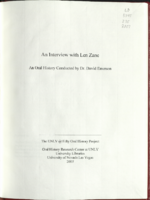Search the Special Collections and Archives Portal
Search Results

Transcript of interview with Len Zane by Dr. David Emerson, May 10, 2007
Date
Archival Collection
Description
Text

Transcript of interview with Robert, Ann, Joseph, Patrick, & David Genoves by Shirley Emerson, August 29, 2013
Date
Archival Collection
Description
Text

Transcript of interview with Barbara Buckley, Kevin Buckley, Michael Buckley, Jill Buckley, and Lindsay Stilwell by Claytee D. White, January 28, 2014
Date
Archival Collection
Description
Text

Transcript of interview with Barry Becker by Barbara Tabach, June 04, 2014
Date
Archival Collection
Description
Text

Transcript of interview with Steve and Linda Casey by Claytee D. White, June 04, 2014
Date
Archival Collection
Description
Text

Transcript of Jim Gans by Claytee D. White, January 20, 2013
Date
Archival Collection
Description
Text

Transcript of interview with Paul Hejmanowski by Lois Goodall, March 13, 2014
Date
Archival Collection
Description
Text

Transcript of interview with Mary Laub by Wendy Starkweather, December 02, 2013
Date
Archival Collection
Description
Text

Transcript of interview with Frank Leone by Lisa Gioia-Acres, November 13, 2007
Date
Archival Collection
Description
Text

Transcript of interview with D. Taylor by Claytee White, July 25, 2014
Date
Archival Collection
Description
D. Taylor knew from the time he graduated Georgetown University he wanted to make his career in the labor movement. He credits his Virginia-born mother as an early mentor; she was at once “nice,” “tough,” “genteel,” and “liberal,” and she instilled these values in her son. As a new college grad, Taylor headed west to Lake Tahoe, where he was hired in 1981 by the Culinary Union to organize workers and oversee an eleven-and-a-half-month strike. Culinary then sent him to organize Las Vegas in 1984, a few years after Ronald Reagan crushed the 1981 Professional Air Traffic Controllers Organization strike and only months after the Amalgamated Transit Union strike against Greyhound went down in defeat. In this interview, Taylor recalls that in 1984, most Las Vegas casinos were no longer owned by individuals and families but by multinational corporations that refused to negotiate improved health insurance coverage for their workers. Taylor led a citywide strike that ultimately cost the union six casinos and about eight thousand members. In 1987, Culinary sent him back to Las Vegas, where he has remained. He tells the history of the union in Las Vegas and its leadership, especially crediting Al Bramlet in the 1970s for recruiting a diverse workforce and promoting casino hiring through the union. In 1987 Taylor changed the union rep structure to give a larger voice to Las Vegas’s racially diverse workforce and began recruiting potential leaders of color (like Hattie Canty)—thus, he followed Bramlet’s lead but pushed it further to create a truly bottom-up organization. The husband and father is especially proud of the various programs Culinary Workers Union Local 226 has implemented to improve the lives of Las Vegas union workers and their families but sees widening gaps in the city between those who have great wealth and those who do not. To Taylor, his work is “always about the members. They endure so much. They sacrifice so much.”
Text
